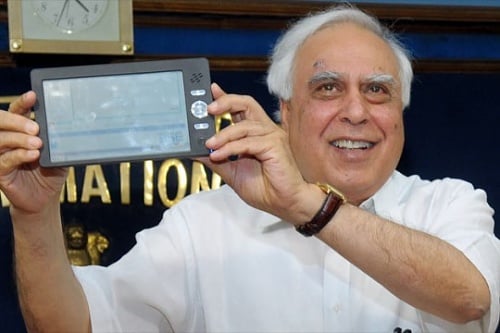Last week, Indian officials unveiled a $35 Linux-based touchscreen computer to the dropped jaws of users holding tablets 16x as much. Capable of web browsing with JavaScript and Flash support, word processing, video conferencing, viewing multimedia content, reading PDF files, and housing USB ports, Wi-Fi, and 2GB of storage, its affordable price tag left some in awe and the rest in disbelief. Slated for release in “early 2011”, the tablet is aimed at university students from roughly 8,500 colleges, allowing affordable access to nearly 500 courses available online in attempts to promote a turn around for a failing countrywide educational system.
"This is our answer to MIT's $100 computer," said Shri Kapil Sibal, the Union Minister for Human Resource Development of India. He is of course referring to the endeavor of Massachusetts Institute of Technology's Media Lab founder and chairman Nicholas Negroponte, who back in 2005, made similar claims regarding his Children’s Machine computer. Its initiative was to revolutionize education in underdeveloped countries by offering an affordable alternative that would help extend internet access abroad. Its inability to gain the momentum of large-scale government purchases kept the price from falling below $200. Its failure to deliver as promised seems extremely foreboding amongst the recent headlines. Other than broad capabilities and vague details about this $35 mystery Indian tablet, little is known about the endeavor. R&D officials have yet to release processing power or memory capacity, leaving many people speculating this is some sort of media stunt to gain press for the advancement of Indian technology or to aid political figures along in the polls.
TheTimes of India released an interesting quote from Kapil Sibal:[INDENT]“At the current price point of $35," Sibal said, "there would be 50% subsidy to educational institutions, which will effectively bring down the cost to only Rs 750. The initial order will be for no less than one lakh [100,000] laptops.”[/INDENT]Does this rhetoric ring a bell? With the admitted intentions of eventually lowering the price down from $35 to an asinine $10 while sitting with fingers crossed hoping for government grants and subsidies, even Nicholas Negroponte would be left shaking his head at the sheer lunacy of these proposals. If there’s one thing my grandma taught me, if something seems too good to be true, it usually is.
Even more puzzling is that at a total estimated billing of $47 for parts, it was never explained at the press conference as to how they determined the $35 price. Included in that same grey area were all manufacturing and distribution details. And the cherry on the speculation sundae: is it even possible for a country to mass produce a laptop that isn't named China? This wouldn’t be the first time Indian officials have blown smoke up the collective pant legs of the entire world. The promises of a $10 laptop (the first time) came back in December of 2008, when Indian R&D announced their work on a laptop named Sakshat. With Wi-Fi, LAN, and 2GB of strorage (sound familiar?), it was touted as India’s next big thing, capable of affording people from all demographics the chance to enter the digital age. When it was publicly revealed in February of 2009 that the Sakshat was neither a laptop nor $10, the wizard behind the curtain didn’t have answers and Kansas had never seemed further away. The $10 centerpiece to what would have been a electronic revolution turned out to be nothing more than a cheap plastic storage hub for students to download lectures from.
So like a prisoner with a long rap sheet, promises of another shockingly priced computer are hard to trust. Let's assume for a second that this is possible and try to put a positive spin on what could potentially be an industry-shattering feat.
For a stroll down Cheap Street, corners will need to be drastically cut.Starting off with a Linux-based system is step one. Leave Microsoft licensing out of the equation and a $35 price certainly seems more feasible.
The included 2GB of storage is reported to be removable, similar to microSD on smartphones, which is certainly a cheaper alternative than a full hard drive.
With labor presumably in India, manufacturing costs would stay reasonably low.
At $35, the tablet is being assembled to essentially be expendable. Being sold in this manner, questions can be raised as to what type of warranty and customer support, or lack thereof, will be available to customers. Assuming the latter, clearing out backend staffing will leave a lot less overhead and a lot more possibility for the project to enter the realm of the believable.
So will this tablet come to fruition, or will it be left to roam the wilderness of tech myths with the allusive Sakshat-quatch? Time will only tell.


